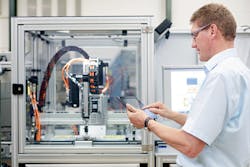Kraus Automation Technology (KAT), a Germany-based OEM specializing in custom systems for life-span, fatigue, and material tests, has long relied on National Instruments’ LabView software to create custom user interfaces for its engineers. LabView’s graphical approach to programming helps KAT engineers visualize the hardware configuration, measurement data, and debugging issues during development of their testing machines.
However, the measurement and testing applications controlled by the programmable logic controllers (PLCs) on KAT’s testing machines had to be engineered separately. Having these two processes—system configuration and application programming—handled in separate process was time-consuming and required specific expertise.
To streamline this process, KAT used Bosch Rexroth’s Open Core Engineering to integrate, model, and automate all drive and control functionalities on KAT’s testing machines into the LabView environment its engineers were familiar with.
This integration provides KAT engineers with full programming control in one programming environment without creating separate PLC code, significantly reducing engineering costs, said Paul Streatfield, strategic product manager at Bosch Rexroth.
Streatfield explained that a specific library, which can be imported into LabView, enables engineers to directly access the control functionalities of Rexroth’s IndraMotion MLC and ILC systems. "It provides the programmer with more than 550 virtual instruments and controls within a single, familiar software environment. KAT now handles the entire engineering function for the jog mode, speed tests, positioning, sensors, and actuators in LabView, with no time-consuming PLC programming required,” he said.
Stefan Beisendorf of KAT said that, prior to the integration of LabView and Open Core Engineering, KAT engineers had to program I/O queries and axis motions separately and then transfer them into a joint machine program at each phase of development. Beyond the added time and costs, these additional programming requirements increased the possibility of errors.
“Open Core Engineering enables us to reduce the number of interfaces. This is efficient, minimizes the risk of errors, and helps to make resource planning more flexible,” said Beisendorf.
In addition to speeding up KAT’s machine development process, the full machine workflow can now be mapped in LabView, which helps speed up the commissioning phase, according to Beisendorf. For KAT, this translates into significant time savings, especially since troubleshooting can be performed in one, rather than two, programming environments.
Leaders relevant to this article:


